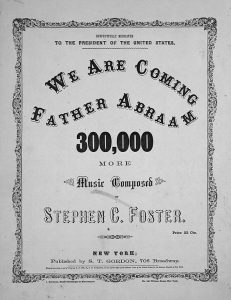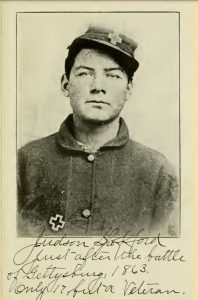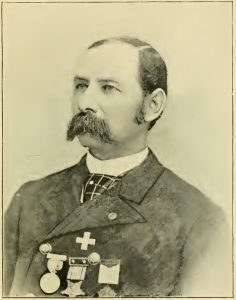“I’ll Take That Chance and Live, Too”: Pvt. Judson Spofford, 10th Vermont Infantry
During the summer of 1862, President Abraham Lincoln pleaded for 300,000 more volunteers to help put down the rebellion. Hundreds of thousands of men answered the call. Thousands of boys joined, too. One such youth, Judson Spofford, enlisted on July 22, 1862, in his hometown of Salem, Vermont. Although his regimental enlistment records claimed he was 18 years old, Spofford was actually two years younger.

Enlisting in Co. K, 10th Vermont Infantry, Pvt. Spofford’s height of 5 feet 7 inches probably helped him appear older than his true age. It is unknown if Spofford’s parents gave him permission to enlist or if he did so on his own. Perhaps his officers knew he was underage as the 10th Vermont’s regimental history notes that, “He was one of the youngest men in the regiment who carried a gun.” Capt. George Davis, although leading a different company, wrote Spofford’s biography in the 1894 edition of their regimental history. In it, Davis noted that the young man was a “clean, modest, polite, obedient, and brave soldier, such as any officer is proud of.”

Pvt. Spofford and the 10th Vermont initially received orders to serve along the Maryland banks of the Potomac River. However, in the summer of 1863, in pursuit of the Army of Northern Virginia after Gettysburg, they joined the First Brigade, Third Division, Third Corps, Army of the Potomac. That fall they participated in the back and forth marching and fighting from central Virginia to northern Virginia and back again, as Meade and Lee attempted to gain an advantage on one another.
Payne’s Farm during the Mine Run Campaign appears to be the 10th Vermont’s first real taste of combat. However, it certainly would not be their last. Through all the marching and camping, Pvt. Spofford seems to have held up extremely well. His service records indicate he did not suffer any illness or injury that required him to leave the regiment from his enlistment through the grueling Overland Campaign, to Petersburg, or in fighting at Monocacy.

At the Battle of Monocacy—now as part of the Sixth Corps—the 10th Vermont’s Capt. Davis wrote that Pvt. Spofford “was in my detail of seventy-five men, he there put in a day’s work for our government of which any man might be proud, if pride is allowable. He was a good marksman and had the range of a well of water near a house in the rebel lines in my front. The enemy were obliged to keep away from that spot all day.” Davis also mentioned that Spofford was one of the last to retreat across the railroad bridge as the Confederates closed in on their retreat. As a bit of praise Davis claimed, “But for his extreme youth, he would have received rapid promotion for the excellent qualities he possessed.”
Pvt. Spofford continued to live about as charmed of a life as a Civil War soldier could expect through service in the Shenandoah Valley during the fall of 1864, and then back to the ever-lengthening Petersburg trenches in December of 1864. Although he had received previous minor wounds in battle, it was not until about two weeks before Appomattox that Spofford’s good luck finally ran out.
On March 25, 1865, Confederate Gen. John B. Gordon attempted to storm and breakthrough the Ninth Corps lines at Fort Stedman, just east of Petersburg. After successfully capturing the position, Gordon’s men were unable to hold it for long. Soon learning about the Confederate failure at Fort Stedman that morning, and believing that the Southern defenses were now weak along other parts of the line, Maj. Gen. Horatio Wright’s Sixth Corps attempted a forward movement later that day to capture the Confederate picket line southwest of Petersburg near the Robert H. Jones’ farm. Fought over part of the old Peebles Farm (Sept. 30-Oct. 2, 1864) battlefield, the Confederates repulsed a weak initial Federal assault. Throwing more weight into a second attack, the Sixth Corps captured the entrenched Confederate picket line, nabbing hundreds of prisoners, and forcing the Southerners to establish a new picket line closer to their main defenses protecting the Boydton Plank Road and Southside Railroad.

During the see-saw fighting at Jones Farm, Pvt. Spofford received a severe wound at about 4:00 pm. Capt. Davis, noted that the Confederate bullet hit Spofford in the right side of the chest, went “through his body, penetrating both right and left lungs, and was just under the skin under the left arm.” Evacuated from the battlefield, Spofford “was taken back to the division hospital and a Surgeon glanced at his wound, pronounced him mortally wounded and left him outside the hospital, on the ground to die,” Davis wrote. Spofford continued to bleed profusely, “his clothing and boots were stiff with it.”
While enduring the cold night air, and still not receiving any attention or medical efforts to at least make him comfortable, Spofford “asked someone passing, if they were not going to take him in and attend to his case. The man said he could do nothing for him as he must die.” Either this attendant or a previous doctor apparently told Spofford that “he did not have one chance in a thousand to live.” Spofford replied, “I’ll take that chance and live, too.”
Pleading to at least go inside to die so he would not be so cold, they finally relented. Someone “washed away the blood, removed the clotted clothing and examined the wound.” A surgeon eventually cut out the bullet just below the skin of his left arm pit and attempted to keep the ball. The bold young soldier “told the Surgeon if he wanted relics, there were plenty more up on the line where he found that one, and [the surgeon] could go there and get all he wanted, but he could not have that one,” Davis noted. Spofford kept the bullet as a keepsake.
Drawing a piece of silk cloth through the wound from end to end in attempt to clean it, clear the clots, and remove pieces of clothing carried into it, Spofford’s wounds then received bandaging. Eventually evacuated to Lincoln Hospital in Washington D. C., where a doctors photographed his wound, he then went on the Sloan General Hospital in Montpelier, Vermont, for extended recovery. Spofford’s Civil War was over as his comrades pursued Lee’s army to Appomattox, and then served on occupation duty in Virginia. Although Pvt. Spofford technically mustered out with the 10th Vermont in the summer of 1865, not being with the regiment, he never received a formal discharge. He wrote to get one in 1867.

After the war, Spofford remained in Vermont for about three years. He married Nellie Goodall in 1868, and the couple eventually had three children. Judson and Nellie moved to West Virginia that same year. They lived in Huntington, where Spofford served as postmaster before resigning in 1884. Eventually moving to Boise, Idaho, in hopes of receiving benefits of a healthier climate, Spofford worked in railroads, raising livestock, and various mining interests before finally retiring. Judson Spofford died in Boise on September 11, 1937, at age 91. His body traveled east for interment with full military honors at Arlington National Cemetery, where he rests in peace today.
Sources:
Compiled Military Service Record for Pvt. Judson Spofford, Co. K, 10th Vermont Infantry, accessed via Fold3.com
Hawley, James H. History of Idaho: The Gem of the Mountains, Vol. 2. Chicago: S. J. Clark Publishing Co., 1920.
Haynes, E. M., A History of the 10th Regiment Vermont Volunteers. The Tuttle Company, 1894.
Wow! These “up close and personal” accounts are why I continue to follow Emerging Civil War. Thanks!
Glad you enjoyed it. Thank you!
God bless him. Great article. Thanks
There are so many fascinating soldier stories to explore. Thank you for reading!
Very interesting story! Thanks! I am a member of the Vermont Civil War Hemlocks a living history organization that was founded in 1963 and is dedicated to preserving Vermont’s Civil War history and reenacting it. We portray Co. A 3rd VT infantry and the 1st VT battery. I appreciate this article! Thank you very much! We are currently working on bringing the artifacts of Danville Vermont’s most famous Civil War soldier: Colonel Addison W Preston of the 1st VT Cavalry home to Vermont. Thank you again for the great story!
Thank you for the kind words!
Great Story!
I am a descendent of his sister Callista. I have been able to visit his grave in Arlington. My grandmother remembered him visiting when he was quite elderly.
I just found this story while researching Judson Spofford, who is a 4th cousin, 4th generation back. I’ve found quite a lot about him, but had never seen these photos before! Thanks so much!